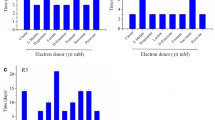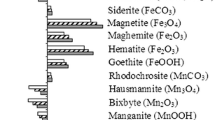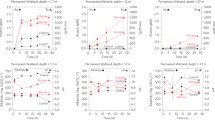Abstract
It was well established that microbial communities are the major drive for the formation of arsenic-contaminated groundwater. However, it remains to be elucidated for how nitrate/nitrite affects the microorganisms-catalyzed dissolution and reduction of arsenic. To address this issue, we collected soil samples containing high-contents of arsenic from the Shimen Realgar Mine area. Microcosm assay indicated that addition of nitrate/nitrite significantly inhibited the dissolution, reduction and release of As and Fe caused by the biological catalysis of microbial communities in the soils, meanwhile nitrate/nitrite was reduced into N2. To further investigate the molecular mechanism of this finding, we used a representative dissimilatory arsenate-respiring strain Shewanella sp. GL90 from the soils to perform the arsenic release assay. GL90 can efficiently catalyze the reductive dissolution, and promote the release of As and Fe in soils. It is interesting to see that the addition of nitrate/nitrite to the soils led to marked decreases in the GL90-mediated dissolution of As and Fe in the soils. Moreover, we found that this finding was attributed to that nitrate/nitrite significantly inhibited the transcription of the gene of the respiratory arsenate reductase protein in GL90 cells. This work provided new insights into the mechanisms for the coupling of As, N and Fe geochemical cycles in arsenic-rich soils, and for how environmental factors affect As concentration in groundwater.






Similar content being viewed by others
References
Barringer JL, Mumford A, Young LY, Reilly PA, Bonin JL, Rosman R (2010) Pathways for arsenic from sediments to groundwater to streams: biogeochemical processes in the Inner Coastal Plain, New Jersey, USA. Water Res 44(19):5532–5544
Burton ED, Johnston SG, Kocar BD (2014) Arsenic mobility during flooding of contaminated soil: the effect of microbial sulfate reduction. Environ Sci Technol 48(23):13660–13667
Broderick KE, Singh V, Zhuang S, Kambo A, Chen JC, Sharma VS, Pilz RB, Boss GR (2005) Nitric oxide scavenging by the cobalamin precursor cobinamide. J Biol Chem 280:8678–8685
Chen CJ (2014) Health hazards and mitigation of chronic poisoning from arsenic in drinking water: Taiwan experiences. Rev Environ Health 29(1–2):13–19
Chen X, Zeng XC, Wang J, Deng Y, Ma T, E G, Mu Y, Yang Y, Li H, Wang Y (2017) Microbial communities involved in arsenic mobilization and release from the deep sediments into groundwater in Jianghan plain. Cent. China. Sci Total Environ 579:989–999
Chung CJ, Huang YL, Huang YK, Wu MM, Chen SY, Hsueh YM, Chen CJ (2013) Urinary arsenic profiles and the risks of cancer mortality: a population based 20-year follow-up study in arseniasis-endemic areas in Taiwan. Environ Res 122(2):25–30
Clancy TM, Hayes KF, Raskin L (2013) Arsenic waste management: A critical review of testing and disposal of arsenic-bearing solid wastes generated during arsenic removal from drinking water. Environ Sci Technol 47(19):10799–10812
Cui S, Shi Y, Groffman PM, Schlesinger WH, Zhu YG (2013) Centennial-scale analysis of the creation and fate of reactive nitrogen in China (1910–2010). Proc Natl Acad Sci USA 110:2052–2057
Fendorf S, Michael HA, van Geen A (2010) Spatial and temporal variations of groundwater arsenic in South and Southeast Asia. Science 328(5982):1123–1127
Fiedler T, Bekker M, Jonsson M, Mehmeti I, Pritzschke A, Siemens N et al. (2011) Characterization of three lactic acid bacteria and their isogenic ldh deletion mutants shows optimization for YATP (cell mass produced per mole of ATP) at their physiological pHs. Appl Environ Microbiol 77(2):612–617
Fisher JC, Wallschlager D, Planer-Friendrich B, JT H (2008) A new role for sulfur in arsenic cycling. Environ Sci Technol 42(1):81–85
Georgiadis M, Cai Y, Solo-Gabriele HM (2006) Extraction of arsenate and arsenite species from soils and sediments. Environ Pollut 141(1):22–29
Ghosh S, Sar P (2013) Identification and characterization of metabolic properties of bacterial populations recovered from arsenic contaminated ground water of North East India (Assam). Water Res 47(19):6992–7005
Giloteaux L, Holmes DE, Williams KH, Wrighton KC, Wilkins MJ, Montgomery AP, Smith JA, Orellana R, Thompson CA, Roper TJ, Long PE, Lovley DR (2013) Characterization and transcription of arsenic respiration and resistance genes during in situ uranium bioremediation. ISME J 7:370–383
Gu B, Dong X, Peng C, Luo W, Chang J, Ge Y (2012) The long-term impact of urbanization on nitrogen patterns and dynamics in Shanghai, China. Environ Pollut 171:30–37
Haque S, Ji J, Johannesson KH (2008) Evaluating mobilization and transport of arsenic in sediments and groundwaters of Aquia aquifer, Maryland, USA. J Contam Hydrol 99:68–84
Harvey CF, Swartz CH, Badruzzaman ABM, Keon Blute N, Yu W, Ali MA, Jay J, Beckie R, Niedan V, Brabander D, Oates PM, Ashfaque KN, Islam S, Hemond HF, Ahmed MF (2002) Arsenic mobility and groundwater extraction in Bangladesh. Science 298(5598):1602–1606
Hudak PF (2000) Regional trends in nitrate content of Texas groundwater. J Hydrol 228:37–47
Islam FS, Gault AG, Boothman C, Polya DA, Charnock JM, Chatterjee D, Lloyd JR (2004) Role of metal-reducing bacteria in arsenic release from Bengal delta sediments. Nature 430(6995):68–71
Jiang S, Lee JH, Kim D, Kanaly RA, Kim MG, Hur HG (2013) Differential arsenic mobilization from As-bearing ferrihydrite by iron-respiring shewanella strains with different arsenic-reducing activities. Environ Sci Technol 47:8616–8623
Kaushal SS, Groffman PM, Band LE, Elliott EM, Shields CA, Kendall C (2011) Tracking nonpoint source nitrogen pollution in human-impacted watersheds. Environ Sci Technol 45:8225–8232
Kim DJ, Lee DI, Keller J (2006) Effect of temperature and free ammonia on nitrification and nitrite accumulation in landfill leachate and analysis of its nitrifying bacterial community by FISH. Bioresour Technol 97:459–468
Kudo K, Yamaguchi N, Makino T, Ohtsuka T, Kimura K, Dong DT, Amachi S (2013) Release of arsenic from soil by a novel dissimilatory arsenate-reducing bacterium, Anaeromyxobacter sp. strain PSR-1. Appl Environ Microbiol 79:4635–4642
Li H, Zeng XC, He Z, Chen X, E G, Han Y, Wang Y (2016) Long-term performance of rapid oxidation of arsenite in simulated groundwater using a population of arsenite-oxidizing microorganisms in a bioreactor. Water Res 101:393–401
Lièvremont D, Bertin PN, Lett MC (2009) Arsenic in contaminated waters: Biogeochemical cycle, microbial metabolism and biotreatment processes. Biochimie 91(10):1229–1237
Liu T, Wang F, Michalski G, Xia X, Liu S (2013) Using 15N, 17O, and 18O to determine nitrate sources in the Yellow River, China. Environ Sci Technol 47:13412–13421
Mumford AC, Barringer JL, Benzel WM, Reilly PA, Young LY (2012) Microbial transformations of arsenic: mobilization from glauconitic sediments to water. Water Res 46(9):2859–2868
Nordstrom DK (2002) Worldwide occurrences of arsenic in ground water. Science 296(5576):2143–2145
Ohtsuka T, Yamaguchi N, Makino T, Sakurai K, Kimura K, Kudo K, Homma E, Dong DT, Amachi S (2013) Arsenic dissolution from Japanese paddy soil by a dissimilatory arsenate-reducing bacterium Geobacter sp. OR-1. Environ Sci Technol 47:6263–6271
Osborne TH, McArthur JM, Sikdar PK, Santini JM (2015) Isolation of an arsenate-respiring bacterium from a redox front in an arsenic-polluted aquifer in West Bengal, Bengal basin. Environ Sci Technol 49:4193–4199
Park S, Lee JH, Shin TJ, Hur HG, Kim MG (2018) Adsorption and incorporation of arsenic to biogenic lepidocrocite formed in the presence of ferrous iron during denitrification by Paracoccus denitrificans. Environ Sci Technol 52(17):9983–9991
Rodríguez-Lado L, Sun G, Berg M, Zhang Q, Xue H, Zheng Q, Johnson CA (2013) Groundwater arsenic contamination throughout China. Science 341(6148):866–868
Roh T, Lynch CF, Weyer P, Wang K, Kelly KM, Ludewig G (2017) Low level arsenic exposure from drinking water is associated with prostate cancer in Iowa. Environ Res 159(22):338–343
Sharma P, Rolle M, Kocar BD, Fendorf S, Kapppler A (2010) Influence of natural organic matter on as transport and retention. Environ Sci Technol 45(2):546–553
Song B, Chyun E, Jaffé PR, Ward BB (2009) Molecular methods to detect and monitor dissimilatory arsenate-respiring bacteria (DARB) in sediments. FEMS Microbiol Ecol 68:108–117
Wang P, Sun G, Jia Y, Meharg AA, Zhu Y (2014) A review on completing arsenic biogeochemical cycle: Microbial volatilization of arsines in environment. J Environ Sci (China) 26:371–381
Wang JN, Zeng XC, Zhu XB, Chen XM, Zeng X, Mu Y, Yang Y, Wang Y (2017a) Sulfate enhances the dissimilatory arsenate-respiring prokaryotes-mediated mobilization, reduction and release of insoluble arsenic and iron from the arsenic-rich sediments into groundwater. J Hazard Mater 339:409–417
Wang N, Xue XM, Juhasz AL, Chang ZZ, Li HB (2017b) Biochar increases arsenic release from an anaerobic paddy soil due to enhanced microbial reduction of iron and arsenic. Environ Pollut 220:514–522
Weng TN, Liu CW, Kao YH, Hsiao SSY (2017) Isotopic evidence of nitrogen sources and nitrogen transformation in arsenic-contaminated groundwater. Sci Total Environ 578:167–185
Xu R, Zhang K, Liu P, Khan A, Xiong J, Tian F, Li X (2017) A critical review on the interaction of substrate nutrient balance and microbial community structure and function in anaerobic co-digestion. Bioresour Technol 247:1119–1127
Yao L, Chen C, Liu G, Liu W (2018) Sediment nitrogen cycling rates and microbial abundance along a submerged vegetation gradient in a eutrophic lake. Sci Total Environ 616–617:899–907
Yu X, Jiang Y, Huang H, Shi J, Wu K, Zhang P, Lv J, Li H, He H, Liu P, Li X (2016) Simultaneous aerobic denitrification and Cr(VI) reduction by Pseudomonas brassicacearum LZ-4 in wastewater. Bioresour Technol 221:121–129
Zeng XC, E G, Wang J, Wang N, Chen X, Mu Y, Li H, Yang Y, Liu Y, Wang Y (2016) Functions and unique diversity of genes and microorganisms involved in arsenite oxidation from the tailings of a realgar mine. Appl Environ Microbiol 82:7019–7029
Zhang SY, Zhao FJ, Sun GX, Su JQ, Yang XR, Li H, Zhu YG (2015) Diversity and abundance of arsenic biotransformation genes in paddy soils from southern China. Environ Sci Technol 49(7):4138–4146
Zhang J, Zhao S, Xu Y, Zhou W, Huang K, Zhao FJ (2017) Nitrate stimulates anaerobic microbial arsenite oxidation in paddy soils. Environ Sci Technol 51:4377–4386
Acknowledgements
This work was supported by the General Programs and the Foundation for Innovative Research Groups of the National Natural Science Foundation of China (grant nos. 41472219 and 41521001).
Author information
Authors and Affiliations
Corresponding author
Ethics declarations
Conflict of interest
The authors declare that they have no conflict of interest.
Ethical approval
This article does not contain any studies with human participants or animals performed by any of the author.
Additional information
Publisher’s note: Springer Nature remains neutral with regard to jurisdictional claims in published maps and institutional affiliations.
Supplementary information
Rights and permissions
About this article
Cite this article
Zhu, X., Zeng, XC., Chen, X. et al. Inhibitory effect of nitrate/nitrite on the microbial reductive dissolution of arsenic and iron from soils into pore water. Ecotoxicology 28, 528–538 (2019). https://doi.org/10.1007/s10646-019-02050-0
Accepted:
Published:
Issue Date:
DOI: https://doi.org/10.1007/s10646-019-02050-0




